Mazur: Sotheby's Pre-Auction Euphronios Transcript
The Sotheby's (Pre-Auction) Euphronios Transcript
Sotheby's Experts Discuss Hunt Euphronios Sale (1990 Taped Interview)
By Suzan Mazur
One of my ancient coin clients had recently been defeated after a long stay in the U.S. Senate. John Tunney, a Democrat, was very interested in making money. When I asked him [in 1980] if he'd be interested in lobbying on Bunker [Hunt]'s behalf [for a Fed bailout following the Hunt brothers' attempt to corner the silver market which led to a price collapse and Wall Street brokers sinking along with their bankers who'd put up hundreds of millions of dollars in loans], he was suprisingly receptive. . . . In the weeks that followed, John Tunney met with the Fed chairman, Paul Volker, a number of times. . . . [The] Fed approved the loan and Congress did nothing to halt it. Bunker got his $1.3 billion. John and I pocketed commissions exceeding $6 million each. Remarkably, throughout the silver crisis, Bunker and Herbert continued to spend literally tens of millions of dollars on coins and antiquities gathered by me via Bob Hecht, Jiri Frel [former Getty museum curator], and a worldwide network of sources. . . . They even bought their own pieces by Euphronios, a krater and a kylix. Both were obtained through Bob Hecht and bore the shadows that all of Hecht's items carried.
- Bruce McNall, Fun While It Lasted
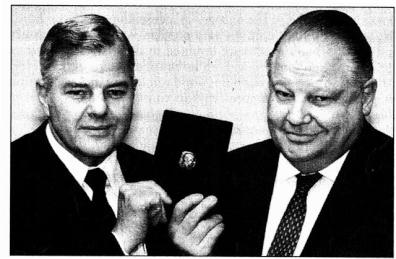
Caption: Herbert, Athena & Bunker
In the 1970s oil boom years, before Mu-ammar al-Gaddafi nationalized Bunker Hunt's oilfield and the silver market collapsed, he and brother Herbert amassed a quarter-ton of ancient coins and some astonishing pieces of ancient art. These were put up for sale in New York on June 19, 1990 to appease the Internal Revenue Service and the Hunts' various creditors, and raised more than $20 million. The Hunts bargained for a 60% commission over the benchmark figure on total sales.
I had arranged for a private preview of the auction pieces with Sotheby's experts two weeks earlier, June 4, as part of my coverage for an article for The Economist magazine. Following are excerpts from my taped interview of that preview.
There is discussion on tape of the fragmentary krater (vase) painted by the Athenian master Euphronios as well as a kylix (cup) -- his earliest existing work. Both were on Sotheby's block, June 19, 1990, as lots #5 and #6, respectively. It is astonishing how many experts internationally viewed, studied, wrote descriptive pieces about, and exhibited the objects without raising questions that might have stopped Sotheby's sale. Click here: Scoop: Antiquities Whistleblower Oscar White Muscarella
The kylix is currently in pieces in a cardboard box in Rome after laundering in America's ancient art market, as Vernon Silver of Bloomberg first reported. It was purchased at the auction by Italian art dealer, Giacomo Medici, who's now appealing a 10-year sentence for trafficking antiquities.
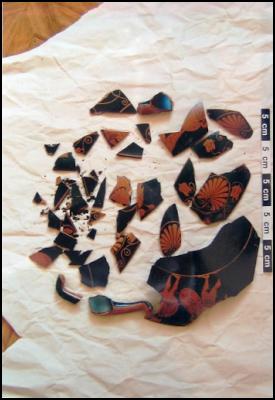
Click for big version
Shattered Euphronios Kylix
The contested krater and kylix are part of the controversy surrounding the antiquities trial underway in Rome involving dealer Bob "Slugger" Hecht and former Getty curator Marion True -- each accused of trafficking looted ancient art.
True has appeared to testify and Hecht has told Italy's lawyer Maurizio Fiorilli that he will answer charges in court mid-January or early February.
June 4,
1990 -- Sotheby's
David N. Redden, Sotheby's Vice Chair (then EVP):
David N. Redden, Sotheby's Vice Chair (then EVP): I know they [Hunt brothers] had an interest in history and I know that that is one of the sources of their collecting interest. I think that Herbert Hunt, particularly. . . First of all, they consciously chose noncompeting areas to collect in because they're quite close - the two brothers.
As Bunker chose Greek and Roman coins - the extension of Greek and Roman is essentially Byzantine coins, which is what Herbert chose. Bunker took Greek vases; Herbert took Greek and Roman Bronzes. He's always had a particular interest in bronzes actually from the days of some interest in Western American Bronzes. . . .
I also know that Bunker Hunt had a coin collection since he was a child. Herbert Hunt inherited that coin collection when Bunker Hunt went off to boarding school. So there was a childhood background in collecting.
Suzan Mazur: What kinds of coins did they collect?
David Redden: They were American coins, which is what many American boys and girls of those days did [collect]. Bunker was interested in some other areas too. He [Bunker] had a collection of sporting paintings at one point. But these were the most substantial collections and these were the only collections as far as I know that exist still, because they've had to liquidate pretty much everything they own.
Suzan Mazur: But they still have some money, don't they?
David Redden: Well, they certainly both have declared personal bankruptcy - well they're out of bankruptcy now. They, I think, under Texas law, whatever, they're allowed to retain a residence, a car and then certain other assets at the discretion of the court.
Suzan Mazur: Money from the sale will go to them [Hunts] or to the creditors?
David Redden: No the proceeds of this sale will go primarily to their creditors, although they may get some residual interest in the sale. I don't think all that's been worked out yet. It's not something Sotheby's has obviously been a party to particularly. But the lion's share of whatever happens here will go to their creditors, primarily the IRS.
Suzan Mazur: Who do you think will be interested in the collection? Who do you think some primary buyers will be?
David Redden: Clearly, anybody who's interested in antiquities or ancient coins.
Suzan Mazur: Do you think we'll see these going to the Japanese?
David Redden: We took highlights of the collection to Tokyo and Osaka [also to London, Frankfurt, Munich, Monte Carlo, Zurich, Geneva, Hong Kong and Singapore]. The Japanese have not traditionally been major buyers of ancient coins, although they have selectively been interested in ancient works of art. And I think there will be some interest from Japan, but I think the primary buyers will be American and European. I mean it's not like Impressionist paintings.
[A Roman Bronze nude of a youth did go to a Japanese dealer for half a million dollars with few, if any other bids; I noted that both Hecht and his Atlantis Antiquities Gallery financier, Jonathan Rosen, told me prior to the auction that the piece was a fake. It had previously been exhibited at the Metropolitan Museum of Art, Museum of Fine Arts--Boston and at Andre Emmerich's gallery in New York.]
Suzan Mazur: Is there anything particularly intriguing about any piece in the collection that has an incredible history?David Redden: I'd like you to talk to the experts who are involved with this but, in fact, yes. I would say there are a number of pieces here that have some wonderful stories to tell one way or another. . . .
One thing I should say so that you can put this in context, and that is, these collections are truly astonishing. These are not run-of-the-mill collections. They are the best of their kind. . . . I've been getting reports back from our traveling exhibitions and apparently the excitement amongst the collectors and some of the dealers and cognoscenti out there is absolutely palpable.
Suzan Mazur: Particularly for the Euphronios vase.
David Redden: Well I think for everything. It depends who you talk to because it depends what their interests are. But I had a gentleman around here the other day who was there with the Greek Bronzes. And he went berserk over the bronzes! Absolutely berserk over them!
There are other people, for instance, from Paris where we had a view at the end of last week. The coins were absolutely besieged with people! And our coin people said they were absolutely amazed because we hadn't held a coin exhibition in Paris before.
We'd gone all over the place around there but we did one in Paris in addition to one in Geneva, Frankfurt and London. And they said it was astonishing how much interest there was.
Suzan Mazur: The Athenian coin [dekadrachm] resembles the Elmali coin hoard [looted from Turkey].
David Redden: Which I don't know.
Click for big version
Photos by: George Obremski - Top left Silver Dekadrahm of Athens, struck in 465B.C. at end of Persian wars, honoring the patron goddess Athena shown here in crested helmet; owl on reverse side. The coin sold for $480,000. Also pictured, a Bronze Hydria, 5th century B.C., referred to later in interview with Sotheby's antiquities expert Richard Keresey.Suzan Mazur: Which is the one there was a whole to do about on the cover of Connoisseur (Ozgen Acar/Melik Kaylan, "The Hoard of the Century", July '88).
David Redden: Oh yes that one I do know about. Yes. It's not from the same collection. But it is the same coin - the Athenian Dekadrachm. Except I believe - although ask the coin people -- the Athenian Dekadrachm in the Bunker Hunt collection is the finest of them all.
But it's ironic because I guess there were 14 dekadrachm in the world. When this one entered the Hunt collection, and therefore, was of the highest rarity. And the hoard you're talking of, another eight were discovered, which made it slightly less rare. On the other hand, it's still the best, I believe.
[ Dr. Arnold R. Saslow, Director, Rare Coins & Classical Arts, told me following the Hunt-Sotheby's sale that by the auction house showing the coins all over the world "they finally got people - most of them were on the phone, but some of them were sitting in the room - to actually say: 'These are art. ' The one [Athenian Dekadrachm] that sold for $480,000 is far inferior to the dekadrachm hoard from [Elmali] Turkey which have sold for $250,000 [each]. Those are mint condition."]
David Redden: Yes - [the collection has a representation of every dekadrachm - 12] from the various city-states of ancient Greece.Suzan Mazur: And what about the Euphronios vase? Do you know where that's from? Where was it purchased?
David Redden: Well, I do know where it was purchased. Virtually everything in the two sales was bought with the help of an agent named Bruce McNall, who is the principal in a firm that deals in antiquities and coins on the West Coast in Los Angeles called Numismatics Fine Arts and Summa Galleries. He was the seller to the Hunts, I think, of virtually every piece here in one way or another.
Suzan Mazur: Including the coins.
[McNall was Bob Hecht's partner in Summa. He was also the producer of the film that launched the career of Matthew Broderick -- War Games. And McNall owned the LA Kings hockey team besides being a high roller in the coin business with Merrill Lynch; he went to jail in the 1990s for overvaluing coins and later wrote a book Fun While It Lasted.
In 1988, McNall tried to sell at auction a number of coins found in Emali, Turkey in 1984, which had been consigned to him by William Koch, an oil heir and a trustee of the Museum of Fine Arts--Boston. During the auction the Turkish government appeared, claimed cultural patrimony and regained possession of the coins, which were said to have been smuggled out of the country by the Turkish Mafia. McNall's consignment included an Athenian Decadrachm which, for some reason, had been withdrawn from sale; and six of the coins from the Elmali hoard were at the time of the Hunt auction still said to be missing; it was unclear how many were being held by Koch.]
David Redden: Yes. He [McNall] worked very closely with the Hunts in putting together this collection and they all came through him.Suzan Mazur: But you don't know where the vase was actually found?
David Redden: No. And, in fact, I mean. No. There's no way that one knows. I mean one knows certainly about the one in the Metropolitan Museum of Art. There's a lot of speculation about where that came from. But again there was no conclusive proof of where it came from. Otherwise it would be. . .
Suzan Mazur: Yeah, otherwise it may not be there. . .
David Redden: Because there were some allegations at the time that it might have been a recent discovery in which case it would have been illegally excavated. . .
[ Robin Riley-Ahrens (Sotheby's press) scores a well-timed interruption, saying "the catalogue has a wonderful introduction about the history of collecting antiquities that really puts it all in perspective . . . it gives a historical overview starting from the various vases Greek & Roman . . . really fascinating to read."]
David Redden: Also, all the antiquities including the two Euphronios vases, and also all the coins in the evening sale on June 19th were exhibited in museums all over the United States in the early 1980s in an exhibition called "Wealth of the Ancient World"
[First at the Kimbell Art Museum in Fort Worth, Texas -- June 1983, then at the Virginia Museum of Fine Arts -- October 1983; Detroit Institute of Art -- March 1984; Dallas Museum of Art -- April 1984; and the High Museum in Atlanta --1985-86.]
David Redden: Good then. Have a look at your objects.
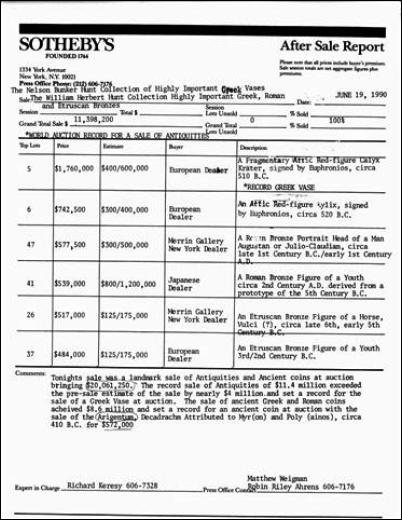
Click for big version
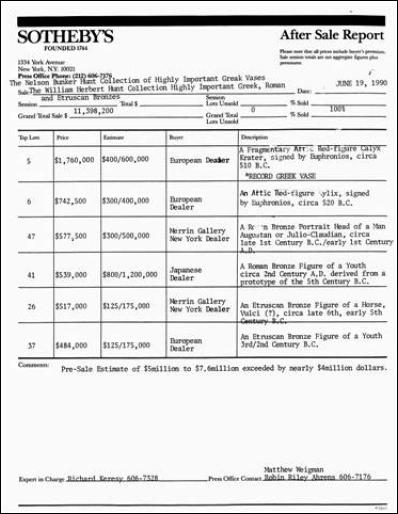
Click for big version

Richard Keresey, Sotheby's Worldwide Antiquities Director (then-Antiquities Expert):
[Discussion opens with conversation about a "Greek" bronze hydria (used to carry and pour water) from Herbert Hunt's collection with rare two-lion combination on beaded vertical handle, one lion looks over the neck wide-eyed with wavy mane, bared teeth, protruding tongue, ears pricked; forepaws of lion-skin on handle base. Sotheby's catalogue notes bronze vessels of this type survived because they were "placed in tombs where they were often used as cinerary urns". Sotheby's sold to a European buyer for $410,000.]
Suzan Mazur: . . . Is this East Greek, is it Lydian, what?Richard Keresey: No, it's probably if anything West Greek. Certainly Greek. I should think it's probably made in south Italy like I guess many of these coins were - in the early 5th century B.C. I don't know whether you could prove whether it was either Greek from the mainland or Greek from the colonies or not. . . . The form is probably pretty much standard form in pottery, but of course, the pottery was copied into bronze. Bronze survivals are rare. Conventionally used for scooping water out of a krater. You lifted it out with these handles and poured it into the krater. . . .
Richard Keresey: [Discussing Euphronios-signed fragmentary calyx krater, circa 510BC.]
But you know, the incredible detail, the incredible confidence with which he draws. That's his leg armor, for example, or the bottom of his foot. The eyes which he's trying to show Kyknos dying with the eyes rolled up [Kynos, son of Ares, god of war].
One of the things I love about Euphronios as a man is that he . . . John Boardman who writes beautifully about these things because he's an art critic seems to see in him. . .
Suzan Mazur: Did he write this [in the catalogue] or you wrote this?
Richard Keresey: I wrote this but here I quoted him. . . . Euphronios and the other painters of his generation, Euthymedes, etc. seemed to form a conscious movement. A kind of camaraderie of artists like we might have in Paris in the 20s in the cafes. And on one of Euthymedes' vases he signed his vase: "As never Euphronios" meaning Euphronios never did this well. What that seems to suggest is that they had a little bit of a friendly kind of rivalry.
[Keresey also writes: "Euphronios, among the greatest of Greek vase painters, was--along with Phintias and Euthymedes--a pioneer in the freer drawing which developed with the advent of the red-figure technique. He signed at least six vases as painter, and later in his career, ten as potter (mainly for Onesimos)."]
Suzan Mazur: You think that this particular vase will sell for how much?Richard Keresey: Our estimate is $400,000 - $600,000.
Suzan Mazur: What is the star of the collection, the principal piece?
Richard Keresey: Of the Bunker Hunt collection. See there are really two separate collections.
Suzan Mazur: It would be this coin [the Athena coin]
Richard Keresey: and then I would say the Euphronios krater.
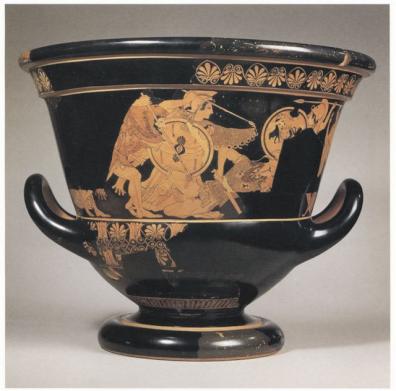
Suzan Mazur: The Euphronios krater.
Richard Keresey: Now the cup.
The details. That's right the kylix. It's funny. In the Greek pottery field they call it a cup but the kylix is the more specific term for this type of cup. This is a wine cup. There's always a wine cup. That's right. But they're also gifted away to people. The kylix, which is important. It supersonic in many ways.
This is signed by Euphronios. The signature is on the foot.It's staggering to not only have a vase by Euphronios in the collection but maybe all of it -- I'm not sure. There aren't that many to start with. I mean we've never had a signed vase by anyone. By any of the ancient artists.
This shows the death of Sarpedon (The Lycian Prince), which is the same subject that's on the Met krater. And it shows it in slightly different. I think it shows it earlier -- or later. Later. Later in the narrative.
Suzan Mazur: [Sarpedon] is being carried away by the gods Sleep. . .
Richard Keresey: That's right. Thanatos and [Thanatos (Death) and Hypnos (Sleep)]. Well, I'd just be reading, but it's here [in the catalogue].
[ Background Conversation:
Riley-Ahrens (Sotheby's press): Ooouu, ooouu nah nah nah -- No. Let's not do that!
Photographer George Obremski (who accompanied me to the interview, trying to position an object to shoot): Can you hold that just a second?
Riley-Ahrens: Okay.]
Richard Keresey: This is thought to be maybe to be the earliest work by Euphronios.
[
Background: Sotheby's coin expert Mish Tworkowski: This
might be the most expensive photo session you [Obremski] ever
shot!]
Suzan Mazur: And what was the date on that [kylix]?Richard Keresey: 520 BC. . . .
Richard Keresey: This is an actual prize amphora that was awarded at the Panathenaic Games in Athens. It's about this tall. They awarded.these vases as prizes [designed to hold 10 gallons of olive oil].
[The piece went at auction to New York dealer Ed Merrin for $190,000. Merrin once told me for an Economist magazine story that he does it all "for love." Corporate raider Asher Edelman (inspiration for Michael Douglas' character Gordon Gekko in the film Wall Street) had $10 million invested in Merrin Gallery at the time of the Hunt sale.]
On the front, they have a statue of Athena - a painting of the same statue of Athena that's in Athens and on the back the competition to which the prize vase is awarded. In this case it's a competition, called the pyrrhic. Usually you see runners and you see wrestling. . . Pyrrhic is named after a man - General Pyrrhus. . .Suzan Mazur: And the horse is . . .
Richard Keresey: That's Pegasus. I don't know what the significance of the horse is. Pegasus is on her shield. But this particular painter - the Kleophrades painter also uses Pegasus on his shields. This is one of the prizes of Athens.
Suzan Mazur: Pegusus in general represented what?
Richard Keresey: Pegasus was the steed of Bellerophon.
Here's Pegasus. Bellerophon riding Pegasus. Bellerophon was the son of Poseidon and the ancestor of Sarpedon.
All of these tasks that he was set to do he overcame brilliantly with the aid of his winged steed, Pegasus. Who was also the offspring of Poseidon [and Eurymede] with the Gorgon Medusa by his side. I hope I got that right.
Suzan Mazur: I look forward to reading it. This is very exciting. . . .
Robin Riley-Ahrens (Sotheby's press): Do you want to pop over and see the Euphronios vase?
Richard Keresey: Yes. I think I've got the key to that room. . . .
Richard Keresey: [Discussing the Euphronios vase] There are some incised areas on black-figure vases but not on this. . .
That's a Gorgon head. She [Athena] always has this head of a Gorgon on her armor. There's another one on her shield here. Meant to frighten you away. This is totally blank. They painted around the terra cotta . . . over the terra cotta . . .
Richard Keresey: Here's the [Euphronios] cup.
Suzan Mazur: Quite a lot of wine.
Richard Keresey: A lot of wine. They mixed their wine with water. The bubbles. . . He signed the foot on the other side.
. . . Usually they wrote over. I think that's what they did here. Yes. He's written in red like his signature. But here these names are in reserve [Sarpedon, Thanatos, etc.]Suzan Mazur: And how much of this is reconstructed?
Richard Keresey: Pretty much what you can see. The crackled parts. But again, fortunately, most of the main . . .
Suzan Mazur: The art work. Yeah.
Richard Keresey: is preserved.
Suzan Mazur: Is it heavy?
Richard Keresey: You can hold it..
[I pick up the Euphronios cup.]
Suzan Mazur: I'd better hold it with both hands.Richard Keresey: They broke all the time I think in antiquity but they always had repairers.
Riley-Ahrens: Where are the main restorers? In the States or in Europe?
Richard Keresey: I think mostly in Europe.
Suzan Mazur: [Discussion shifts to Euphronios vase.] Are there substantial restorations on this?
Richard Keresey: This is 75% restored. All of this is plastic. That's why it's such a low estimate. What you're really estimating here are the fragments. And people do love fragments. . .
[The Euphronios fragmentary vase went to Leon Levy at the Hunt Sotheby's auction for $1.7 million. Levy was the late husband of collector Shelby White, who is a member of the Met board of trustees.
According to Vernon Silver of Bloomberg, the Met privately negotiated for the Euphronios wine cup through Sotheby's following the Hunt sale for $742,000 to Medici. Medici said no to the Met offer. The cup was shattered in a 1995 police raid of Medici's Geneva warehouse. Other pieces with a Sotheby's label were found in the warehouse at the time, including three more vases from the Hunt auction:
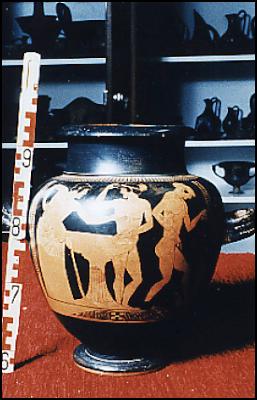
Click for big version
Attic Red-figure Stamnos, Siren Painter, circa 480B.C.
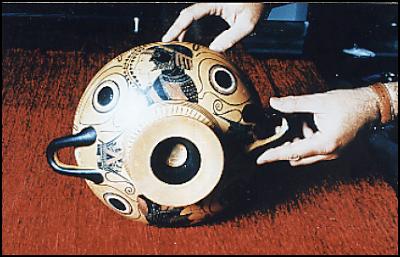
Click for big
version
Attic Black-figure Kylix, Kallis
Painter, circa 540-530B.C.
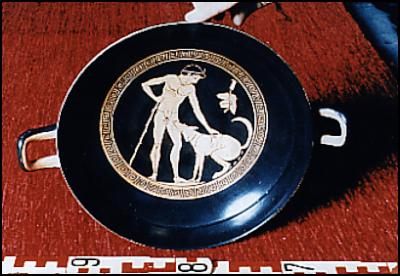
Click for big
version
Attic Red-figure Kylix,
Triptolemos Painter, circa 490-480 B.C.
Three images above- http://www.archaeology.org] . . .
Suzan Mazur: How can you tell that's Artemis [feet-only showing]?Richard Keresey: Actually, I read it. I couldn't tell. She [Artemis] is normally associated with other vases. In fact, I don't know how you can tell this is Aphrodite [standing behind Ares, god of war]. One of the reasons is that it says Aphrodite. . . .
Suzan Mazur: And the auction of these pieces is at the same time or before the coins.
Ahrens-Riley: June 19 will be the antiquities and then Greek and Roman coins that night.
Richard Keresey: The coins continue the day after. And then the coins will continue again. [2,800 Greek & Roman, 13,000 Byzantine and 8,000 Islamic coins]
Suzan Mazur: But there's nothing earlier than that.
Ahrens-Riley: The 15th [June] they go on view.
Suzan Mazur: I see. . . . Well this is very exciting.
 Suzan
Mazur's stories on art and antiquities have been published
in The Economist, Financial Times, Connoisseur, Archaeology
(cover) and Newsday. Some of her other reports have
appeared on PBS, CBC and MBC. She has been a guest on
McLaughlin, Charlie Rose and various Fox television news
programs. Email:
sznmzr@aol.com
Suzan
Mazur's stories on art and antiquities have been published
in The Economist, Financial Times, Connoisseur, Archaeology
(cover) and Newsday. Some of her other reports have
appeared on PBS, CBC and MBC. She has been a guest on
McLaughlin, Charlie Rose and various Fox television news
programs. Email:
sznmzr@aol.com



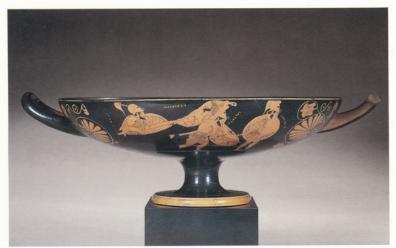
 Binoy Kampmark: Squabbling Siblings - India, Pakistan And Operation Sindoor
Binoy Kampmark: Squabbling Siblings - India, Pakistan And Operation Sindoor Gordon Campbell: On Budget 2025
Gordon Campbell: On Budget 2025 Keith Rankin: Using Cuba 1962 To Explain Trump's Brinkmanship
Keith Rankin: Using Cuba 1962 To Explain Trump's Brinkmanship Binoy Kampmark: The Killing Of Israeli Embassy Staffers - Netanyahu’s Antisemitism Canard
Binoy Kampmark: The Killing Of Israeli Embassy Staffers - Netanyahu’s Antisemitism Canard Keith Rankin: Zero-Sum Fiscal Narratives
Keith Rankin: Zero-Sum Fiscal Narratives Eugene Doyle: Chinese Jet Shoots Down France’s Best Fighter; NZ And Australia Should Pay Attention
Eugene Doyle: Chinese Jet Shoots Down France’s Best Fighter; NZ And Australia Should Pay Attention